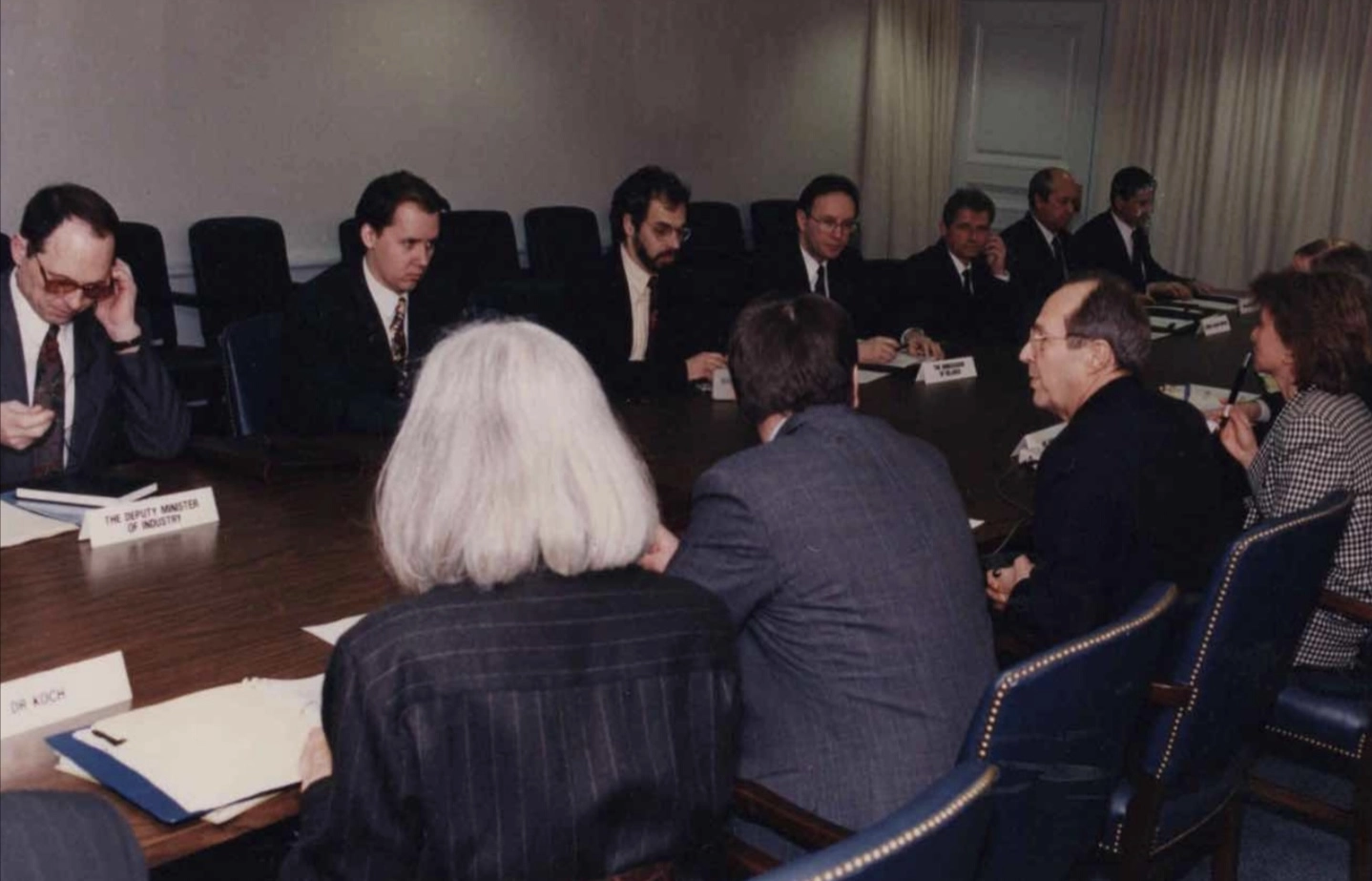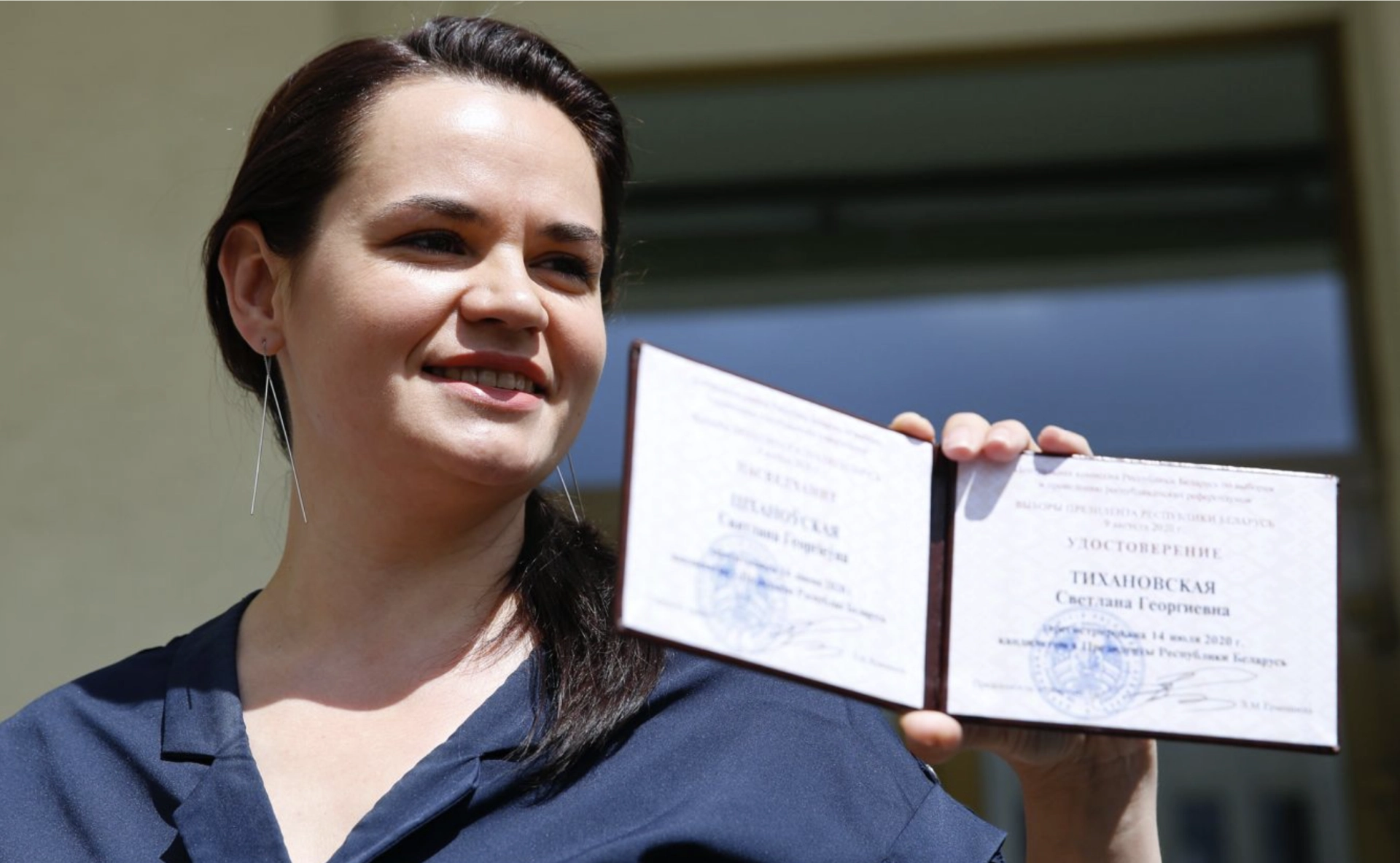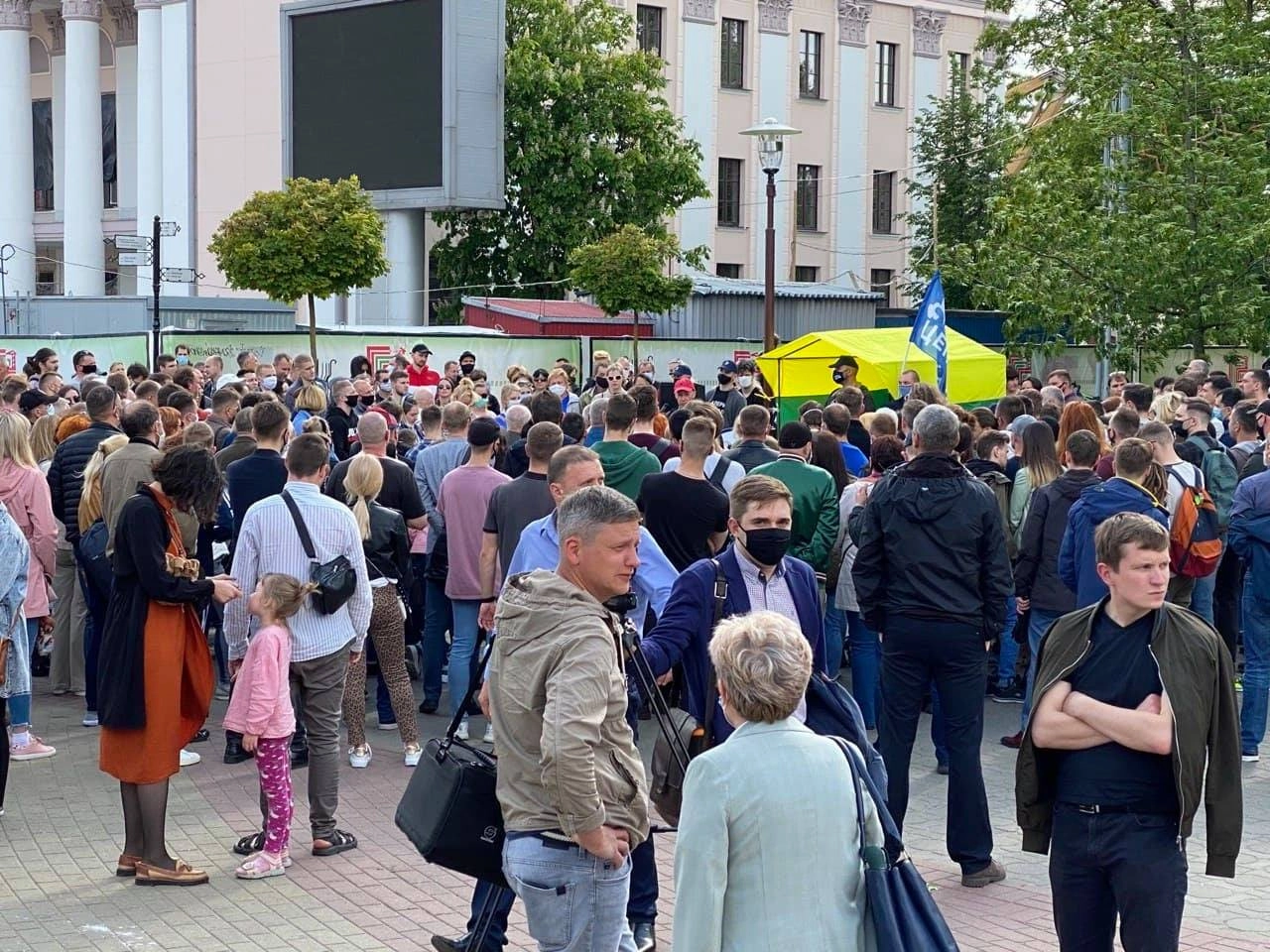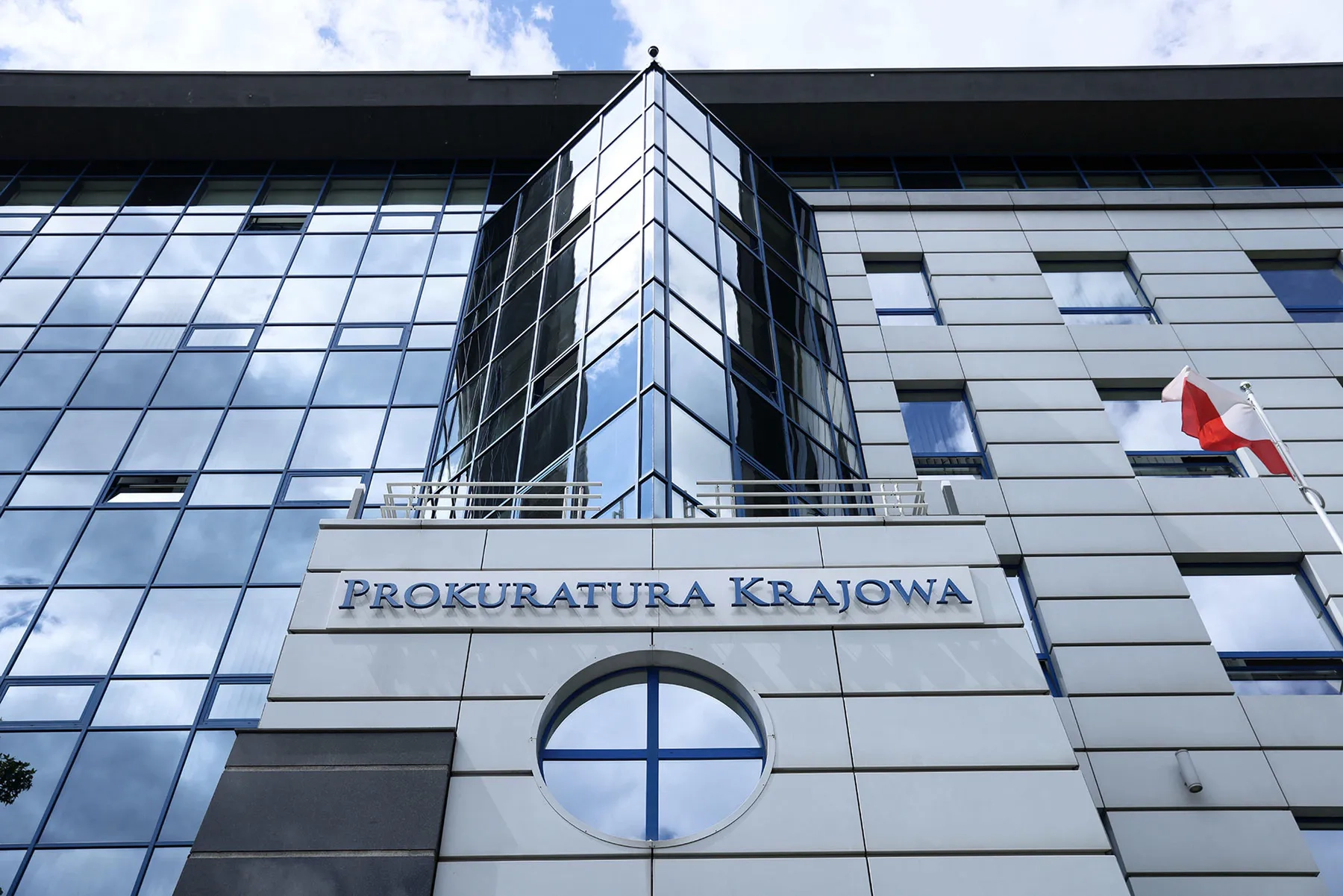Ildar Daminov: The connection between international security, disarmament, and industrial modernization certainly presents interest, though it might appear somewhat incidental. However, what intrigues me more is your personal experience with Belarusian enterprises specializing in machinery manufacturing, microelectronics, or instrumentation. What specifically in your experiences led you to move away from the idea of modernizing existing industries in favor of developing the IT sector?
Valery Tsepkalo: Initially, my career was far from diplomacy. My original specialty had nothing to do with international relations—I was trained as an engineer. I studied Chemical Engineering and Technology at the Belarusian Technological Institute (now BNTU), with a specialization in machinery and equipment for chemical production. Subjects such as theoretical mechanics, strength of materials, and the theory of machines and mechanisms captivated me. I even won the Belarusian Olympiad in theoretical mechanics and later became a laureate of the All-Union Olympiad. Under the supervision of Professor Sergey Stepanovich Makarevich, I conducted research on the stability of stepped rods considering material creep. Had it not been for military service, I would have pursued engineering rather than diplomacy.
Unlike many who discuss industrial production based solely on theoretical knowledge or occasional visits to factories, I gained firsthand experience of actual manufacturing environments. While I cannot claim, as was typical in Soviet-era biographies, that I "worked my way up from welder to plant director," I genuinely experienced industrial work, handled tools myself, and became intimately familiar with the environment, including the distinct "smell of metal."
My practical experience began at the Minsk Refrigerator Plant, working in the welding workshop. Later, I repaired instrumentation and automation equipment at the Grodno "Azot" chemical plant. Subsequently, I worked at the Repair and Mechanical Plant in Grodno, where we serviced military vehicle engines. It was there I truly understood what it meant to work under harsh conditions. The workshop was filled with deafening noise, and floors soaked with machine oil were dangerously slippery—one careless step could result in falling beneath the metal tables where engines were disassembled, and parts were cleaned using chemical solutions. The harsh chemical fumes made breathing difficult and caused discomfort.
Years later, when visiting factories in the United States, I saw vastly different working conditions. It became clear to me that it made no difference to workers and engineers whether a plant was privately owned or state-run, overseen by an anonymous official in Minsk who took no personal responsibility for enterprise development.
Far more important were factors such as competitive salaries, effective incentive systems (rewarding teams based on their performance), clean air free of harmful impurities, modern machinery operating without excessive noise or vibration, comfortable and well-maintained protective clothing, and recreational areas equipped with fitness facilities and leisure spaces. True industrial work isn't about heroically enduring adverse conditions; it's about providing employees with an environment where they can comfortably perform their duties and earn fair compensation.
All of this could only be achieved through effective privatization—not the privatization model seen in Russia, where assets ended up controlled by government insiders, but integration into large international corporations willing to build long-term partnerships with Belarusian enterprises.
At the time, Belarus faced hyperinflation. Money depreciated so quickly that economic planning became impossible. The unstable financial system dramatically reduced the valuation of Belarusian enterprises, discouraging long-term investments. Consequently, when then-Prime Minister Mikhail Chigir proposed that I participate in developing a reform program and engage in negotiations with the International Monetary Fund for a stand-by loan, I readily agreed.
Chigir, who previously headed Belagroprombank, thoroughly understood finance and the specific challenges facing Belarusian industry and agriculture. Meanwhile, my expertise was in catch-up economic development. Having lived in Finland and studied the experiences of Southeast Asian countries—which at that time were experiencing remarkable economic success and achieving double-digit GDP growth—I brought international perspective to our discussions.
We frequently met, debated, and exchanged ideas. Sometimes, we continued these discussions at Chigir’s home over tea. On one occasion, I brought Akira Tateyama, head of the Japanese embassy, whom I had known since my time as an advisor to the Chairman of the Supreme Soviet. At my request, Tateyama organized a seminar in Japan dedicated to financial market regulation in emerging economies. This period coincided with my writing "The Dragon's Path," a study of how Belarus could apply successful economic strategies from Southeast Asia.
Our collaboration resulted in a market reform program presented to the IMF. The program proposed privatizing state enterprises through integration with major international corporations (following successful examples from Czechia and East Germany) and included several critical economic initiatives: developing private farming with gradual land ownership implementation, reducing bureaucratic barriers for private business, exempting technological equipment imports from VAT and customs duties, providing tax incentives for innovative enterprises, establishing free economic zones and technology parks, and creating comprehensive training and professional development programs.
Ildar Daminov: What about Poland’s experience? How does it compare? The country has achieved notable economic growth—especially in industrial modernization.
Valery Tsepkalo: At the beginning of our reforms, we didn't initially see Poland as a positive example. At that time, Poland's industrial production had fallen by a third, and nearly half of its enterprises were on the verge of bankruptcy. Poles were purchasing virtually everything from us—televisions, refrigerators, household appliances, furniture, textiles, and even horse harnesses. As far as we could tell, Poland was in economic decline.
Later I became closely acquainted with the Polish experience through my friendship with Jerzy Kozminski, the former Polish ambassador to the United States, who at that time was deeply involved in economic reform programs as the head of the Polish-American Freedom Foundation. We spent considerable time discussing economic development in our region and globally, and he introduced me to the transformative nature of Poland’s economic reforms.
We believed that, with the right reforms, Belarus could also become a leading economy in Europe. Once our reform program was approved, we enthusiastically promoted it to key international donors such as France, Germany, and the United States.
Our optimism was further fueled by tremendous international interest. At the time, Belarus seemed to hold significant potential compared to its neighbors. Lithuania, for example, had almost no industrial base left, and Latvia struggled financially to the extent that people couldn’t even adequately heat their homes.
Let me illustrate with a couple of episodes. At that time, I led Belarusian-Lithuanian and Belarusian-Latvian commissions. Our responsibilities included not only border issues but also economic cooperation, which gave me insight into the condition of Lithuania's economy. Lithuania's economy was struggling so severely that its leaders requested from us even military equipment—once we provided them a tank so they could train their infantry, as they lacked the means for such exercises. Belarus had surplus tanks, and we provided one to Lithuania upon request.
In 2004, when Lithuanian Prime Minister Algirdas Brazauskas invited me to speak at a conference in Vilnius, I was struck by the poor infrastructure, such as barely warm water and weak water pressure at my hotel. During our conversation, Brazauskas explained the difficulties they faced in maintaining and restoring historical buildings. I suggested that Lithuania could follow the example set by Moscow’s mayor at the time, Yuri Luzhkov, who repossessed buildings if owners failed to restore them within two or three years. Brazauskas smiled and replied, “We can't talk like that to property owners here.” Nevertheless, within 5 year only Lithuania transformed its capital into one of Europe’s most beautiful cities through comprehensive renovation.
If someone had told me back then that Lithuania—a country of just three million people—would learn to build better, more attractively, and faster than Belarus, eventually catching up to and surpassing our ten-million-strong nation in GDP within twenty years, I would have considered that person out of their mind. Unfortunately, reality turned out to be even more troubling. Over the past decades, the Belarusian construction industry hasn't just failed to advance—it has rapidly deteriorated. One needs only to look at developments like Minsk Lighthouse, Minsk World, and other major projects to see symbols of mismanagement, corruption, and complete disregard for the living environment.
But all that came later. At the time, aside from meetings with government representatives from leading global nations, our primary focus was collaboration with the IMF's "Belgian group," consisting of the Netherlands, Belgium, and Austria, which supported us in crafting an economic reform program. This group worked with seventeen Central and Eastern European countries, including Belarus, which were in need of funding to support their reforms.
Leading the group was Willy Kiekens, a knowledgeable Belgian financier and IMF executive director. He later played a crucial role in economic transformation programs in the Czech Republic and subsequently Turkey, now one of today's economic leaders. I had numerous discussions with Willy in Washington, where the IMF headquarters are located. In 2011, he even visited Belarus's High-Tech Park, where he was surprised to discover a sector growing at triple-digit rates in a country where all economic indicators otherwise predicted decline—a decline indeed present in every other sector.
At that time, we truly believed in the success of economic reforms, as we clearly understood the conditions necessary for our traditional industrial sectors to thrive. We successfully convinced the IMF's Board of Directors to provide Belarus with a concessional loan of $300 million at an annual interest rate of just 2.5%.
However, much like the Nunn–Lugar program—which was terminated after the dissolution of the Supreme Council, resulting in Belarusian enterprises losing hundreds of millions in potential grants—the IMF funds intended for market reforms were misused. Instead of funding structural transformations, the resources were channeled through the Central Bank to commercial banks at 7% annual interest. Those banks then lent to enterprises at rates between 15–17%, turning these vital resources from tools for economic development into means of banking speculation, placing crippling interest burdens on the real economy.
Then came a sudden surge in energy prices, significantly boosting revenues in neighboring Russia. Belarus, instead of embracing reform and creating a robust economy, chose economic dependency on Russia—trading financial support for declarations of loyalty and allegiance. From then on, subsidies flowed continuously into Belarus's non-competitive factories, freezing their inefficiencies for decades and stripping the country of any realistic opportunity for sustainable economic growth.
The results today are clear. The Czech Republic, with a population similar to Belarus, has achieved a GDP of $343 billion (or $620 billion adjusted for purchasing power parity), thanks to successful reforms. Meanwhile, Belarus remains stagnant with an economy valued around $70 billion, now even lagging behind Lithuania—a country with just one-third the population and virtually no industrial base in the 1990s.
Today, the average salary in the Czech Republic is about $1,600 per month, while Belarus has struggled for two decades, unable to surpass a monthly salary of $500.
I.D.: After, as you've mentioned, the IMF-supported program wasn't implemented, did you abandon the idea of privatization and creating industrial clusters based on existing enterprises, deciding instead to focus on developing the IT sector?
V.Ts.: Yes, but not immediately. I made numerous additional attempts to attract investments to Belarus, including in the technology sector, believing the issue wasn't just about money. Financial injections alone don't guarantee growth; however, integration with global corporations could have served as a powerful economic driver, enhancing competitiveness, expertise, and educational standards.
Around 1997, leading automobile manufacturers gathered to discuss standardization of automotive components—bearings, bushings, and other parts—as part of a global initiative to unify automotive manufacturing. This effort aimed to reduce production costs, simplify logistics, and speed up the development of new car models. The process was similar to standardization seen earlier in video equipment and computing industries, such as VHS formats, followed by CDs and USB connectors, enabling manufacturers to operate within a unified technological environment.
Following the establishment of unified industry standards, automotive corporations began actively merging, and I believed that Belarus needed to participate in this trend.
In 1998, a significant merger took place: Daimler-Benz (producer of Mercedes) united with Chrysler. Although this union later proved unsuccessful—Mercedes subsequently sold Chrysler to Fiat—the overall trend was clear. In 1999, the Renault-Nissan alliance was formed, later joined by Mitsubishi. That same year, Ford acquired Volvo and Land Rover. In 2000, General Motors bought Swedish Saab and German Opel.

I understood that without integration into global manufacturing alliances, Belarus’s machinery industry risked isolation. Conversely, partnering with major automotive and technology corporations would, first, provide access to world-class educational programs, internships, and knowledge exchanges, offering a significant boost to Belarusian engineers, programmers, and managers. Second, it would reduce costs through economies of scale (purchasing 100,000 bearings always results in lower prices per unit compared to buying 10,000), thus increasing profits and improving the competitiveness of Belarusian brands. Finally, this integration would create conditions for local production of components, stimulating the growth of startups oriented towards providing solutions for multinational corporations.
When U.S. Senator Chuck Grassley from Iowa—who later chaired the Senate Finance and Judiciary Committees and is now the interim President of the U.S. Senate—invited me to visit his home state, I gladly accepted. The senator had planned a special tour for ambassadors, featuring visits to farms, processing plants, agricultural exhibitions, and other key sites of the agro-industrial sector.
Grassley proudly emphasized that he was the only active farmer in the U.S. Congress and wanted to personally showcase the structure of the American agricultural economy. One of the unique aspects of the trip was that instead of staying in hotels, we were hosted in the homes of ordinary Americans, allowing for personal connections and a deeper understanding of the local way of life.
Most ambassadors declined the invitation. A trip to Florida, New York, or California, with stays in luxury hotels, was one thing, but traveling to Iowa—a state dominated by endless corn and soybean fields—was quite another.

However, I decided to go, and not just once, but twice. The first time was out of curiosity—I wanted to learn about American agriculture, see rural life firsthand, and better understand the implementation of Abraham Lincoln’s Homestead Act, which played a key role in the Union’s victory during the U.S. Civil War. My second visit was more strategic—to meet with the leadership of John Deere, the world’s largest tractor manufacturer, whose main factories and research centers are located in Iowa.
Senator Chuck Grassley was a classic representative of rural America—open, friendly, and pragmatic. Though his early career had little to do with international politics, he later assumed several influential roles in the U.S. Senate, including Chairman of the Judiciary Committee and the Finance Committee, and now serves as Senate pro tempore President. Despite holding such high positions, Grassley remained down-to-earth, embodying the simplicity and authenticity characteristic of Midwestern farmers.
One day, the senator invited me to breakfast in Congress, right in the parliamentary cafeteria. Our conversation started with general topics, then shifted to the tragic events of September 11, a catastrophe that shook not just America but the entire world. Suddenly, and quite unexpectedly, Grassley made a request.
"We’re planning to go to war with Iraq," he began. "We have reason to believe that this country was involved in the attacks and possesses chemical weapons, posing a threat to international security. Could you secure support from your government?"
I was so taken aback that I nearly choked on my food.
Understanding that a direct refusal would be unwise, I responded diplomatically: "The region is extremely unstable, with deep tensions between Shiites and Sunnis. The situation could quickly spiral out of control…"
I continued offering various arguments, though I knew perfectly well that President George W. Bush’s decision had already been made and that no reasoning would prevent the war. Forget Chuck Grassley—even Colin Powell, whom I greatly respected and had met informally several times before, was forced to shake a vial at the UN, presenting so-called "irrefutable evidence" of Iraq’s weapons of mass destruction.
To my surprise, however, Grassley did not press the issue. It even seemed to me that he had raised the topic merely as a formality—someone had asked him to, so he did, but without much enthusiasm. Then, just as abruptly, he changed the subject.
"Listen," he said excitedly, "we have an annual three-mile race among senators. Last year, I placed third. No one can catch John Kerry, but I think I can beat Ben Nighthorse Campbell (whom I also met several times - V.Ts) if I train harder."
"For that, I need a sparring partner," he continued. "Would you be willing to come to my house every morning at 5:30 AM?" (Of course—what other time would a real farmer wake up if not at the crack of dawn!) "We’ll run together, and afterward, my wife will cook us breakfast—she makes an excellent omelet and oatmeal."
Talk about going from one extreme to another!
I don’t remember exactly what arguments I used to avoid a direct refusal, but I firmly decided: I was not yet ready to sacrifice my health (laughs – I.D.) for the sake of strengthening Belarusian-American relations with such uncertain prospects.

Having declined Grassley’s two requests, I initially thought it might be inappropriate to ask him for a favor in return. Still, I decided to take the risk and requested that the next Iowa tour include a visit to the John Deere factory and a meeting with its leadership. To my surprise, he didn’t even perceive it as a request.
"Fantastic idea!" Chuck responded enthusiastically. "If there are people interested in tractors, we will definitely organize a visit to John Deere!"
I must say—the tractor impressed me. I personally got behind the wheel of this massive machine, far larger than our MTZ-100 models, and took it for a test drive on the proving ground. The test was rigorous, assessing stability, hydraulics, pneumatics, and overall handling.
The tractor was incredibly maneuverable and powerful—the confidence with which it responded to commands was truly impressive. It felt like I was operating not just an agricultural machine, but a piece of cutting-edge engineering.
I was reminded of an interesting story told to me by Vasily Afanasyevich Revyako, chairman of the "Progress" collective farm in the Grodno region.
One day, a tractor driver entered his office. It was clear the man was extremely nervous—shuffling, struggling to find the right words. What particularly struck Revyako was that the driver was holding an expensive bottle of vodka and something else wrapped in a decorative gift bag.
"What is this?" the chairman asked in surprise. "A bribe? For me? What do you want?"
"You purchased two John Deere tractors…" the driver finally managed to say, overcoming his embarrassment. "Can I work on one of them?"
Revyako promptly showed him the door.
I don’t know if he ever granted the driver’s request, but I fully understood the man’s motivation. Having had the chance to test an American tractor myself, I could still recall the feeling of operating such a machine.
After the test drive, we embarked on a tour of John Deere’s manufacturing facilities. Fittingly, we traveled around the site in an electric vehicle—a symbolic touch, reflecting the company’s commitment to innovation.
The production facilities were bright, spacious, and impeccably clean, with floors covered in a special wear-resistant material. There was no dust, dirt, or metal shavings anywhere. The workshops housed state-of-the-art CNC (computer numerical control) lathes and milling machines, enabling high-precision machining with minimal human intervention.
One of the most memorable moments was a conversation with a design engineer responsible for developing and modeling key tractor components. The fundamental difference from the traditional Soviet or post-Soviet approach was that all design and testing began in a virtual environment. Advanced computer programs simulated how components would behave under real-world operating conditions, testing them for various stresses—strength, stability, and torsion resistance.

This approach significantly reduced testing costs and allowed engineers to refine designs to perfection before production even began. The software essentially acted as a virtual testing facility, predicting potential failures and weak points in the components.
After completing the design, the engineer sent the digital blueprint through the internal network directly to a CNC machine. The machine then automatically and with extreme precision manufactured the component exactly as specified in the digital model. Once produced, the part underwent real-world testing, where it was assessed for strength, torsion resistance, and load-bearing capacity using specialized equipment.
Visiting John Deere was an invaluable experience, offering deep insight into an industry where technology plays a pivotal role. I witnessed an entirely different production culture—one focused on efficiency, automation, and employee well-being. It was a prime example of how modern industry should evolve, emphasizing technology, digitalization, and precise engineering.
It became increasingly clear that if Belarus failed to integrate into global manufacturing chains and adopt similar technologies, it would be left behind in the global economic race.
Shifting the conversation toward practical solutions, I proposed the idea of a strategic alliance between the American agricultural machinery giant and the Minsk Tractor Works (MTZ). Among those present at the meeting was Robert Zoellick, head of the U.S. Trade Representative’s Office and later President of the World Bank. He had accepted Chuck Grassley’s invitation to visit Iowa and could potentially co-finance such a deal in the future.
John Deere’s equipment was designed for large agribusinesses in developed countries, where technology, automation, and operator comfort were just as crucial as engine power. Their tractors were widely used across North America, Western Europe, and Australia. When the president of John Deere described the Belarusian tractor as a "good basic tractor," there was neither condescension nor dismissiveness in his words. On the contrary, he respectfully and accurately defined its place in the global market, recognizing the qualities that allowed it to maintain a stable niche.
Minsk Tractor Works had always produced simple, reliable, and relatively inexpensive machines—tractors capable of running on low-quality fuel, enduring harsh climates, withstanding extreme cold, and requiring minimal maintenance. These machines thrived in tough conditions, making them a favorite among farmers who had to rely solely on their own resilience. These very attributes secured MTZ’s strong and stable market share in Eastern Europe, Central Asia, post-Soviet countries, and select African markets.
The two companies operated in largely separate markets, meaning that a potential partnership could strengthen both without direct competition.
I suggested that John Deere’s leadership consider a deal modeled on global automotive industry partnerships. Renault and Nissan had formed an alliance that allowed them to remain independent while benefiting from shared resources. Daimler and Chrysler had focused on merging technology and markets. PSA and Fiat had found a way to create a joint group while preserving two strong brands in distinct market segments.
A partnership between MTZ and John Deere could have followed a similar model. The American company would acquire a 40-50% stake in MTZ, invest in modernizing production lines, and assist the Belarusian factory in adopting modern quality standards. In return, John Deere would gain access to MTZ’s extensive dealer network across the post-Soviet region and Eastern Europe, allowing its equipment to be sold and serviced in areas where no infrastructure previously existed for its maintenance and operation.
At the same time, "Belarus" tractors would enter new markets. John Deere’s dealer networks in North and South America, as well as Asia, could begin offering affordable Belarusian machines to farmers for whom John Deere’s own equipment was too expensive. Together, the two companies could establish a new dealer network in Africa, where both brands previously had limited presence.
This partnership would not create a conflict of interest. John Deere would maintain its position as a premium brand, catering to large agribusinesses and developed farming enterprises. MTZ, on the other hand, would continue providing cost-effective solutions for smaller farms. Instead of competing, the two manufacturers would cover the full spectrum of market needs, ensuring that farmers of all scales could find a tractor suited to their capabilities and requirements.
For MTZ, this would be a breakthrough opportunity previously unimaginable. Access to the world’s largest markets would open enormous prospects: increased production volumes, new investment opportunities, and the launch of additional assembly lines.
The factory would gain access to John Deere’s research centers, cutting-edge engineering bureaus, and the latest design technologies and methodologies. Belarusian specialists could undergo training at John Deere’s leading production sites, acquiring best global practices. This wouldn’t just be economic growth—it would be a true technological leap, elevating Belarusian machinery manufacturing to a fundamentally new level.
These transformations would impact not only management and engineering but also the factory workers themselves. Working conditions would improve, and wages could rise to levels comparable with the IT sector.
Today, the average salary for a worker at John Deere plants is approximately $3 while engineers earn around $6,000–7,000. The company employs 76,000 people worldwide.
The cooperation model I proposed with John Deere could have created 30,000–40,000 jobs at MTZ. Under this framework, the average salary for a worker at the Minsk Tractor Works could have reached approximately $1,500 per month, while engineers could have earned around $3,000–3,500. These salary levels would have been about half of what John Deere employees in the U.S. earn, ensuring significant labor cost savings and making Belarusian production highly competitive. At the same time, such wages would still be considered attractive and respectable for Belarusian specialists and workers.
These calculations were later confirmed by the experience of Taiwanese HTC and South Korean SK Hynix subsidiaries operating in Belarus’s High-Tech Park (HTP). Their business model demonstrated that an average salary of $5,000 per month in Belarus (about half of what their foreign counterparts earn) was seen as extremely advantageous.
Meanwhile, the global trend of automotive mergers continued to accelerate, leaving Belarusian manufacturers on the sidelines of progress. During this time, Volkswagen Group built a true empire, first acquiring German brands Porsche and Audi, then Spanish SEAT, followed by Czech Škoda, British Bentley, French Bugatti, and later, Italian Lamborghini and Ducati.

The French PSA Group brought Peugeot and Citroën under its umbrella before acquiring Opel and Vauxhall. Fiat merged with Chrysler, adding Jeep, Dodge, Maserati, and Alfa Romeo to its ecosystem. Renault Group strengthened its position by acquiring Romanian Dacia and forming a strategic alliance with Nissan and Mitsubishi.
Meanwhile, John Deere, without a partnership with MTZ, successfully entered markets traditionally dominated by Belarusian equipment. It established a firm foothold in the post-Soviet region, Central and Eastern Europe, where MTZ had once been unchallenged, and then expanded aggressively into Africa. In contrast, Belarus’s once-flagship machinery manufacturer continued operating under outdated models, steadily losing ground. First, it was pushed out of North America, then Western Europe, and now even its traditional markets are slipping away.
Had the MTZ–John Deere deal succeeded, other major Belarusian enterprises could have followed a similar path. The Minsk Automobile Plant (MAZ) and the Minsk Wheel Tractor Plant (MZKT) could have formed a strong international alliance with Volkswagen Group, which includes MAN, Scania, and the American Navistar, or they could have joined Daimler Truck AG, home to Mercedes-Benz Trucks, Freightliner, Western Star, and the Japanese brand Fuso. Another alternative could have been a partnership with Volvo Group (Sweden), which owns Volvo Trucks, Renault Trucks, Mack Trucks (USA), and the Japanese UD Trucks (formerly Nissan Diesel).
Agricultural machinery manufacturers Gomselmash and Lidselmash could have integrated into a global agribusiness alliance with CNH Industrial, which includes Case IH, New Holland Agriculture (USA/Italy), and the Austrian brand Steyr.
Similarly, Belkommunmash could have joined one of the existing global bus manufacturing alliances, significantly strengthening its position in the public transportation market.
Finally, Belarusian Automobile Plant (BelAZ), specializing in heavy mining dump trucks, could have become part of one of the leading global mining equipment alliances, such as the American Caterpillar or Japanese Komatsu.
Today, Belarus’s machinery sector could have employed between 120,000 and 150,000 workers, with average salaries of $2,500–3,000—roughly half of what their counterparts in the U.S., Europe, or Japan earn, but still attractive enough to encourage young people to pursue engineering and technical careers. By adopting advanced technologies, production standards, and quality control measures, the prestige of Belarusian brands would have risen significantly, and the quality of manufactured products would have improved dramatically.
Working conditions (and I know firsthand how important this is) would have been significantly enhanced through modernization, improved safety standards, automation, robotics, and the implementation of best global practices in personnel management, motivation, and professional development.
Despite all my efforts, numerous memos, and persistent attempts to advocate for this collaboration, the Belarusian authorities (or rather, one specific individual) refused to concede even a minimal stake in the enterprise. Fear of losing control over state-owned companies ultimately buried a highly promising deal. Minsk Tractor Works continued to operate under the old model, selling products only where they were still being bought while gradually losing its traditional markets. This led not only to the decline of MTZ but to the stagnation of the entire Belarusian automotive industry.
To be continued.









